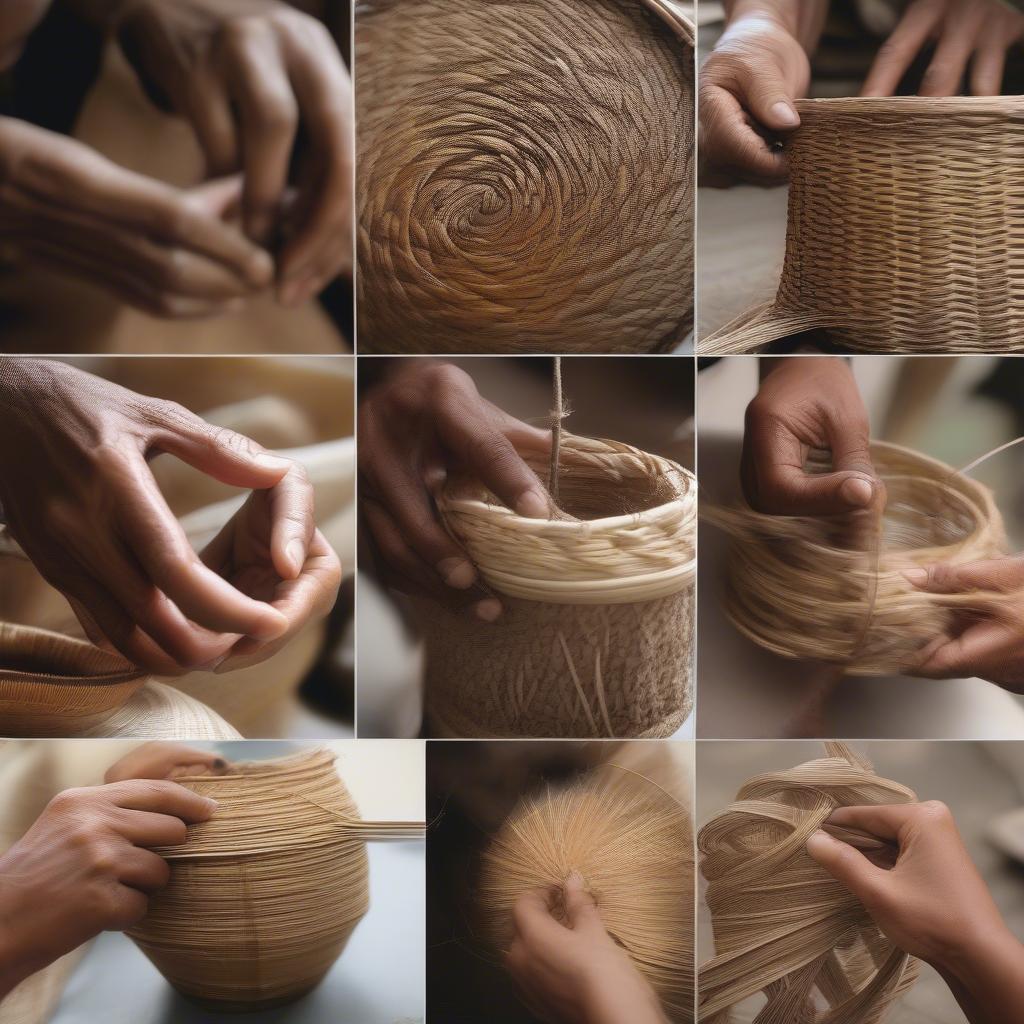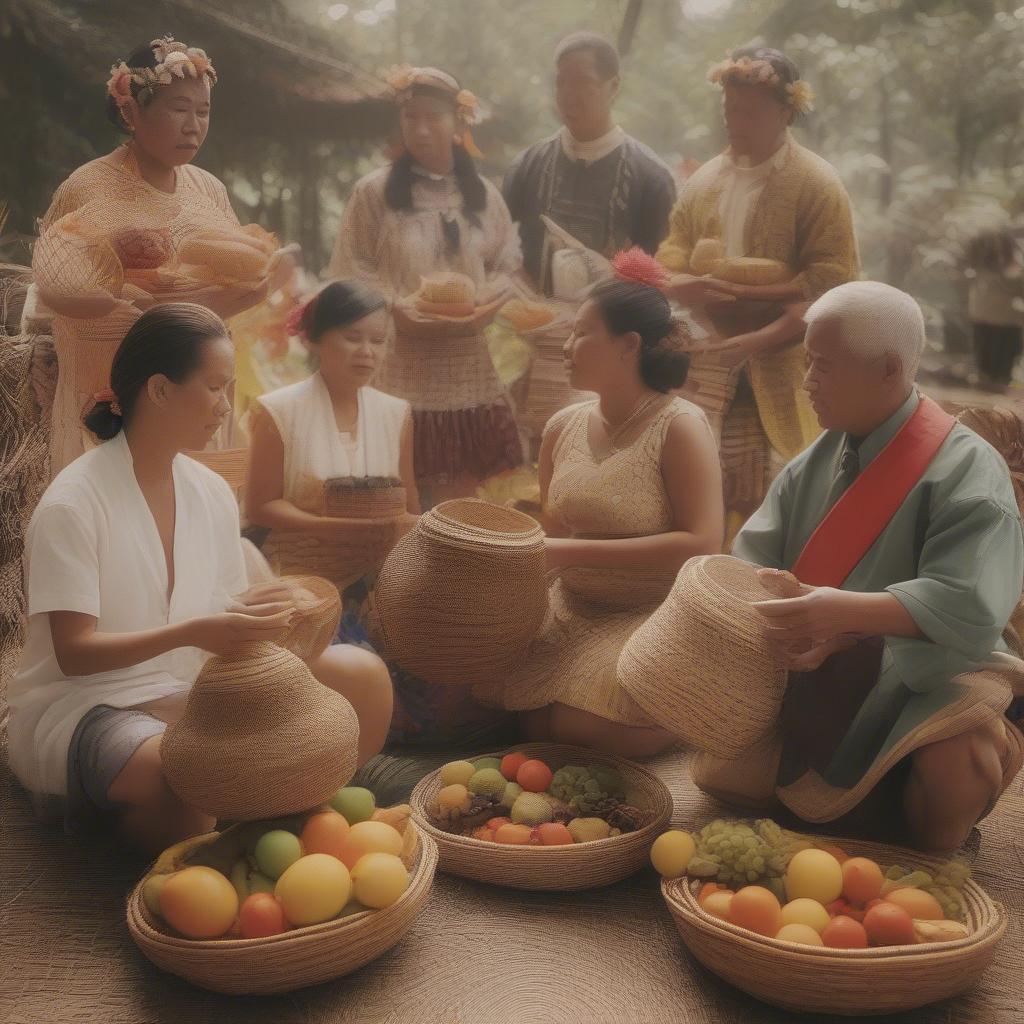Basket Weaving
Discovering the Art of Philippine Basket Weaving
Philippine Basket Weaving is a centuries-old tradition deeply ingrained in the country’s cultural heritage. From practical uses in daily life to intricate ceremonial objects, these woven masterpieces showcase the artistry and skill passed down through generations. This article delves into the fascinating world of Philippine basket weaving, exploring its history, diverse techniques, and cultural significance.  Various Philippine Basket Weaving Techniques
Various Philippine Basket Weaving Techniques
A Legacy Woven in Time: The History of Philippine Basket Weaving
Basket weaving in the Philippines dates back to pre-colonial times, serving as an essential part of everyday life. Early Filipinos utilized readily available natural materials like bamboo, rattan, nito, and pandan leaves to craft baskets for storage, fishing, farming, and trading. These primitive phillipine basket weaving styles were not merely functional; they also reflected the unique aesthetics and beliefs of the different indigenous communities. Over time, these utilitarian objects evolved into intricate works of art, reflecting the evolving cultural landscape of the Philippines.
The Influence of Indigenous Cultures
Each indigenous group in the Philippines has developed its distinctive style of basket weaving, incorporating unique patterns, materials, and techniques. The Ifugao people, known for their rice terraces, create sturdy baskets for harvesting and storage. Meanwhile, the T’boli tribe crafts elaborate baskets adorned with intricate beadwork and brass accents. These diverse famous basket weaving in the philippines demonstrate the rich cultural tapestry of the archipelago.
Materials and Techniques: The Building Blocks of Philippine Baskets
The creation of these woven wonders relies on a combination of readily available natural resources and time-honored techniques. Filipino basket weaving philippines utilizes a range of materials, from the supple strength of rattan to the vibrant hues of dyed pandan leaves. Let’s explore some of the most commonly used materials and techniques:
- Rattan: This strong and flexible vine is a staple in Philippine basketry, providing a sturdy framework for various basket types.
- Bamboo: Known for its durability and lightweight nature, bamboo is ideal for creating larger baskets and containers.
- Nito: A type of fern, nito adds a delicate touch and a natural black color to woven creations.
- Pandan: The leaves of the pandan plant are often dyed and woven to create colorful and intricate patterns.
Weaving Techniques: From Simple to Complex
Philippine basket weaving encompasses a wide range of techniques, each resulting in distinct textures and patterns. Some common methods include:
- Coiling: This technique involves spiraling a foundation material, often rattan or nito, and stitching it together with another material, such as abaca.
- Twining: Twining utilizes two or more flexible materials that are interwoven to create a tight and durable weave.
- Plaiting: Similar to braiding, plaiting involves interlacing strands of material in a flat or three-dimensional pattern.
 Natural Materials Used in Philippine Basket Weaving
Natural Materials Used in Philippine Basket Weaving
The Cultural Significance of Philippine Baskets
Beyond their practical uses, Philippine baskets hold deep cultural significance. They are often used in ceremonies, rituals, and festivals, symbolizing prosperity, abundance, and community. Importance of weaving in the philippines baskets extends beyond mere utility, representing a connection to ancestral traditions and a celebration of Filipino artistry.
Baskets as Symbols and Gifts
In many Filipino communities, baskets are presented as gifts during important occasions, symbolizing respect and goodwill. Elaborately woven baskets are often passed down through generations, becoming treasured heirlooms.
“The intricate designs woven into these baskets are not just patterns,” explains Maria Reyes, a renowned basket weaver from Luzon. “They are stories, passed down through generations, connecting us to our ancestors and their traditions.”
Preserving the Tradition for Future Generations
Today, efforts are being made to preserve and promote the art of Philippine basket weaving. Organizations and individuals are working to support local artisans, provide training opportunities, and raise awareness about the cultural significance of these woven treasures.
“The beauty of Philippine basket weaving lies in its ability to adapt and evolve while staying true to its roots,” adds Antonio Cruz, a cultural anthropologist specializing in Filipino crafts. “It’s a testament to the resilience and creativity of the Filipino people.”
 Philippine Baskets in Cultural Ceremonies
Philippine Baskets in Cultural Ceremonies
Conclusion: The Enduring Beauty of Philippine Basket Weaving
Philippine basket weaving is more than just a craft; it’s a living tradition, a testament to the artistry and ingenuity of the Filipino people. From the place of origin of basket weaving in the philippines to its contemporary evolution, Philippine basket weaving continues to captivate and inspire. By supporting local artisans and appreciating the cultural significance of these woven masterpieces, we can help ensure that this beautiful tradition thrives for generations to come.
When you need assistance, please contact us at Hanoi, Vietnam or Tech Avenue, Suite 12, San Francisco, CA 94105, USA. We have a 24/7 customer support team.
